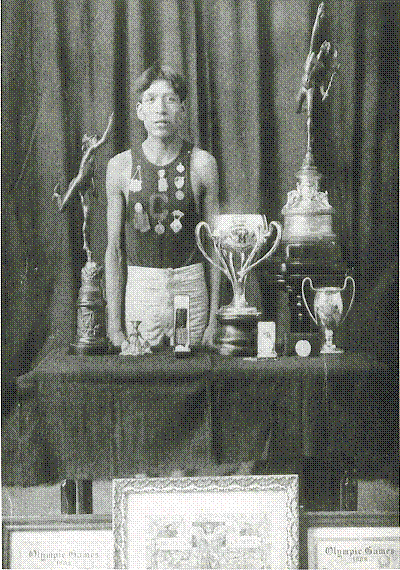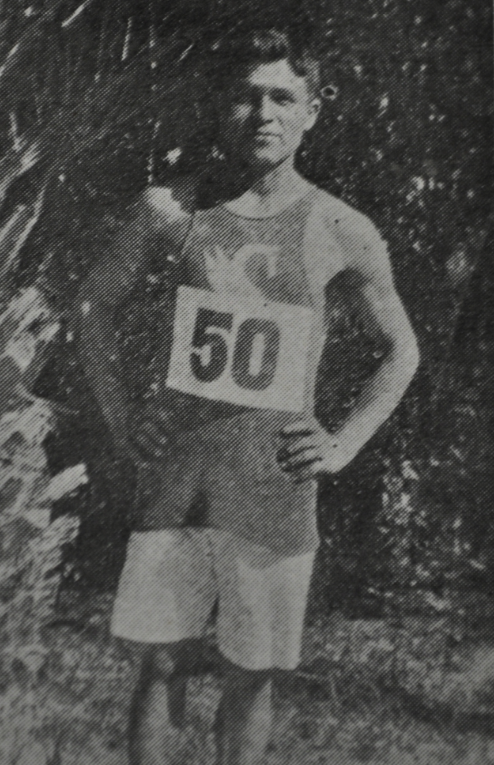
In less than a week, family members of Hopi runner Louis Tewanima will host the 37th Annual Louis Tewanima Footrace at the village of Shungopavi on Second Mesa. Tewanima is one of the most celebrated runners in Hopi history and he is best known for winning a silver medal at the 1912 Olympic Games in Stockholm, Sweden. As I think about the upcoming footrace, I am reminded of another Hopi footrace on Second Mesa that involved Tewanima.
In a previous post, I wrote about a Hopi runner named Philip Zeyouma who competed for Sherman Institute at the same time Tewanima ran for the Carlisle Indian Industrial School in Pennsylvania. In April 1912, Zeyouma won the Los Angeles Times Modified Marathon of 12 miles, which earned him an opportunity to compete for the U.S. team in Stockholm. On the other side of the country, Tewanima, who by this time had won several running events, was also scheduled to run in the Olympics.
When news that the two Hopi runners would race against each other in Sweden, excitement spread among the students at both schools. Students at Sherman Institute gloried in the thought that one of their Hopi runners would defeat the famous Louis Tewanima, and the pupils at Carlisle had great confidence that Tewanima would outrun the Hopi runner from Sherman. But the showdown between Zeyouma and Tewanima at the Olympic Games in Sweden never took place.
Shortly before Zeyouma was supposed to leave for Sweden, his father expressed disapproval of his son’s participation in the Olympics. Not wanting to disappoint his father, Zeyouma honored his request and went back to the Hopi Reservation for the summer. However, in my article “Hopi Footraces and American Marathons, 1912-1930,” I note that the
rivalry between the two Hopi runners did not cease when Tewanima migrated back to the Hopi mesas as an Olympian. In September 1912, shortly before they returned to their schools, Tewanima and Zeyouma challenged each other to a race on the Hopi Reservation. On the day of the race, Hopis from the surrounding villages gathered around the starting line and anxiously watched as the two runners made their mark for the twelve-mile course. Zeyouma proudly wore his “Sherman colors,” while Tewanima “appeared in his Carlisle track suit.”
By wearing their running uniforms, the Hopi athletes saw the event as a race between the two schools and identified themselves according to their school affiliation. However, such a display of school loyalty did not go unchallenged by the other Hopi runners in the crowd. Seconds before the race began, some of the older Hopi men remarked that the “boys did not look like [Hopi] runners” at all, and teased Zeyouma and Tewanima for wearing their running outfits. A New York Times reporter noted that when Tewanima heard the men’s insults, Tewanima replied, “If you don’t like our looks get in, and show what you can do.”
The men promptly accepted his challenge and entered the race with no shoes or track suits, and wore “merely discarded” clothes. Six miles into the race, the older men proved too much for the young runners and Zeyouma and Tewanima quit and left the “race to the barefooted runners in the lead.” Coach Joe Shoulder recalled that the winner was about fifty years old, and he looked like he was “dying of consumption” (tuberculosis).
The outcome of the race provides a telling commentary on running in Hopi culture, as well as the relationship between older and younger runners. While the younger runners migrated to off reservation Indian boarding schools, the vast majority of the Hopi people, including older men who were known for the ability to run long distances, remained at home. Consequently, some of the best long-distance runners in U.S. history received little or no attention by those outside of the Hopi community. Although newspaper reporters seemed surprised that men in their fifties had the ability to defeat the younger athletes, the people knew that other Hopis could easily outrun the Hopi Olympian and the track star from Sherman Institute. [“Hopi Footraces and American Marathons, 1912-1930,” American Quarterly, March 2010, vol. 62, no. 1, p. 87, 88]
On Sunday September 5, 2010, runners of various ages will come together to run a footrace on Second Mesa. They will once again make their mark on the start line and run a course similar to the one taken by Tewanima, Zeyouma, and the older runners of the village. In honor of Tewanima, who still inspires thousands of individuals to run, the annual Louis Tewanima Footrace gives testimony to Tewanima’s legacy as an Olympic runner and the continuation of footraces among the people.
Matthew Sakiestewa Gilbert


Your wonderful article about Hopi runners brought back some fine memories of my coaching and running experience in New Mexico and Arizona while I lived and worked at Thoreau High School. In many of the Invitationals our teams competed against Hopi runners. There was always a fierce competition between my Navajo runners, as well as Zuni and Laguna runners (both men and women). They respected each other but gave no ground during the competitions. In my own personal running experience I too had opportunities to run against Hopi runners. One particular experience stands out. At the Thoreau Red Mesa Mini-Maratho run in about 1980 (13.1 miles) which I was the race director I ran head to head with the then Arizona State Champion in XC from (Hopi High School??). We got to the top of the red rock mesas and would occasionally exchange comments (he often asked about the course since i knew it well). At about ten miles i had told him there was a very steep and rocky downhill to the flats below the mesa. At that point he took off like a rocket. He was fearless and since i was bit older (and maybe wiser) i opted to go down a bit slower. He pulled away on this downhill to win and i came in second. He told me at the finish that he loves downhill and the more treacherous the better!! I think he ran about 1:10 to my 1:12. This was a moment in time with the beautiful sky, large pines and red soil and the occasional sound of our conversations along the top of that mesa. I am sure he is still running as I am. Thanks for shaking this memory loose. Joe
Hi Joe, Many thanks for your comment! I really enjoyed reading about your experience running against the Hopi XC Az State Champ! Do you recall his name? What a great story! – “the more treacherous the better” sounds about right! Glad to hear that you are still running. Thanks again, Matt